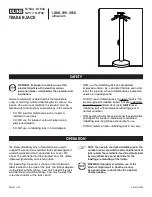
10
PARTE 3
CARATTERISTICHE
TECNICHE
Qui di seguito viene descritto
come calcolare il peso del
pistone.
Esempio:
a - L’esempio si riferisce al
pistone tipo 9100
T63C2L
.
b
Identificare il tipo di
pistone misurando il
diametro “
ØDc
”.
(esempio
120 mm
)
c - Misurare la lunghezza
del pistone “
L
” espressa
in metri.
(esempio:
3,5 m
)
d - Sottrarre a questo valore
0,5 m
(2 stadi) o
0,7 m
(3 stadi).
(esempio:
3,5 - 0,5 = 3
)
e - Moltiplicare il valore
ottenuto per 2 (2 stadi) o
per 3 (3 stadi). Si ottiene
il valore approssimato
della corsa del pistone
“
L0
” espressa in metri.
(esempio:
3 x 2 = 6 m
)
f -
Individuare i valori di
Qp0, Qp1 e QL1 relativi al
pistone nella tabella.
g - Il peso del pistone si
ottiene applicando la
seguente formula:
P = Qp0 + L0 * (Qp1 + QL1)
(esempio:
P = 41 + 6 * ( 30 + 2,1 )
= 233,6 ~ 240 kg
)
h -
240 kg : è il peso
stimato del pistone
.
PART 3
TECHNICAL
CHARACTERISTICS
The following section
describes how to calculate
the weight of the piston.
Example:
a - The example refers to
piston type 9100
T63C2L
.
b
Identify the type of piston
measuring the diameter
“
ØDc
”.
(e.g.
120 mm
)
c - Measure the total length
of the piston (
L
).
(e.g.:
3,5 m
)
d - Subtract to this value
either
0,5 m
(2 stages) or
0,7 m
(3 stages).
(e.g.:
3,5 - 0,5 = 3
)
e - Multiply the obtained
value per 2 (2 stages) or
3 (3 stages). The result is
the approximate value of
the piston stroke “
L0
”
expressed in meters.
(e.g.:
3 x 2 = 6 m
)
f -
Find in the table the
values for Qp0, Qp1 and
QL1 related to the piston.
g - The weight of the piston
is calculated applying the
following formula:
P = Qp0 + L0
*
(Qp1 +
QL1)
(e.g.:
P = 41 + 6
*
( 30 + 2,1 )
= 233,6 ~ 240 kg
)
h -
240 kg : this is the
esteemed weight of the
piston.
Summary of Contents for 9100
Page 1: ...9100 9101 9110 9111 ...
Page 2: ......
















































